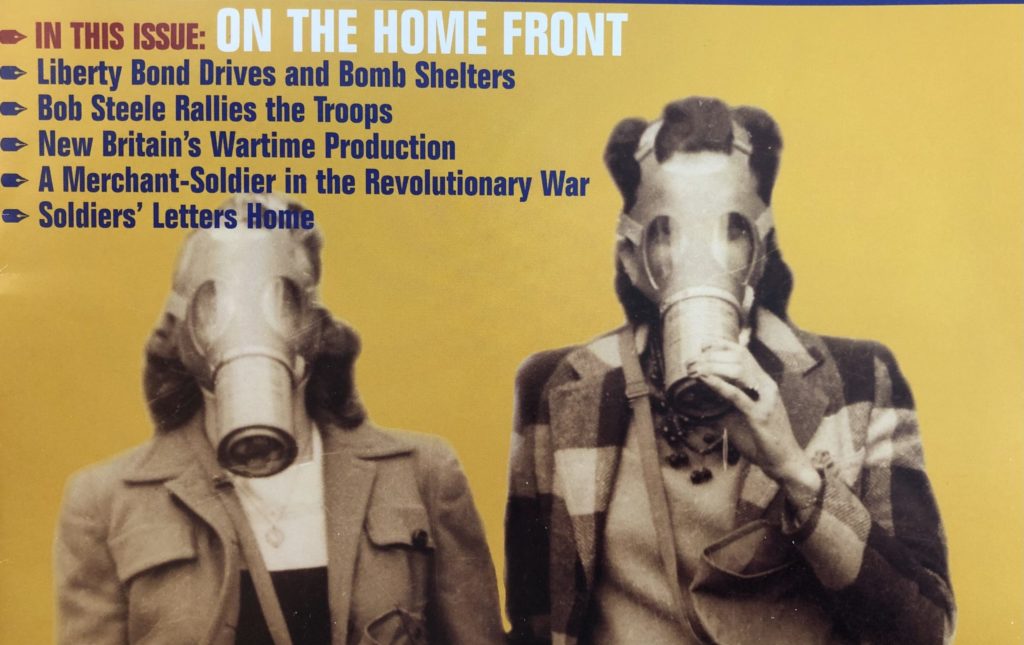
Lois Blomstrann (left) and Arlene Orrechio learning to use gas masks during a drill in 1942. courtesy of Lois Blomstrann
by Lois L.Blomstrann
(c) Connecticut Explored Inc. 2003 Nov/Dec/Jan 2004
Subscribe/Buy the Issue!
By the time of the Civil War New Britain had a number of factories that made not only hardware but turned out military goods such as cavalry equipment and bayonets. The North & Judd Co. supplied the army with silver-plated buckles, hooks and eyes, coat clasps for uniforms, and spurs and saddle hardware. Included in the New Britain Industrial Museum collection is a curry comb recovered from a Union army supply barge, the General Meade, which exploded and sank at City Point , Virginia on the James River . The comb was patented in 1861 by Sarah Jane Wheeler, who was the first woman in New Britain to receive a United States patent. Because so many men lost an arm during the War Between the States, a one-hand combination knife and fork was made by Landers, Frary & Clark, which continued to make them right up until World War II.
During World War I New Britain factories turned out machine gun parts, hand grenades, trench knives, sabers, gun sights, and the only aircraft guns used in the United States. The American Hardware Corp. made gas mask filters, weapon components, marine hardware, and Sutton fuse heads for mortars. Landers, Frary & Clark supplied aluminum mess kits and canteens for the soldiers. When the Germans began to use mustard gas, the call went back to New Britain to create a new filter for the gas masks. Several manufacturers got together and came up with such a filter. Women and school children were called upon for the assembly of the parts so they could be rushed to the front.
Defense contracts sent employment in New Britain soaring from 1942 to 1946 when all of the city’s industries were involved in defense work. American Hardware played a major role in helping to destroy the German U-boat by manufacturing components for torpedoes, mines, and depth-charges. Landers, Frary and Clark again made everything from vacuum bottles to mess kits to gun mounts. Fafnir Bearing supplied precision bearings for everything that moved including large bearings for planes. The New Britain Machine Co. supplied machines across the nation for production of war materiel. The New Britain Industrial Museum has a factory order issued to the Goss & DeLeeuw Company by the U.S. War Department for a Four-Spindle Automatic Chucking Machine, noting that it should be prepared for foreign shipment. The destination was the Union of Soviet Socialist Republics as part of the Lend-Lease program. It is interesting to note that after the war the machine was returned to the U.S. and is now being used in a factory in southern Connecticut and is in good running condition. Also made in New Britain were cartridge clips for rifles, ammunition belts for machine guns, radar parts, shell cases, plane windshield deicers, bomb parts, and marine hardware.
An article appeared in the Stanley World, the in-house newsletter of The Stanley Works during the war quoting a letter that had been received from PFC George Becvar saying, “It makes you homesick to work around the B24 four-engine bombers.” Becvar was part of an aircrew that took the bombers up for testing. On his first flight he found that his tool kit was made by Stanley . The hatches and doors, which received rough treatment, had Stanley butts and hinges, carrying the strain without any trouble. The B24 also carried locks by American Hardware, bearings by Fafnir and vacuum bottles by Landers.
The Industrial Museum also owns several ledgers with the names of factory employees who had deductions taken from their salaries each week to purchase war bonds. Visitors are able to browse through them looking for their names or names of friends or relatives who bought bonds.
More recently Okay Industries has been making magazines for the M-16 rifle and New Britain supplied 500,000 ear plug cases in one year for the soldiers. CW Resources has silk-screened and packaged military vehicle marker plates and put clips on the I.D. chains which every G.I must wear, packaging 657,100 in the past year.
Lois Blomstrann is a founder and member of the executive board of the New Britain Industrial Museum.
Explore!
The New Britain Industrial Museum
59 West Main Street
New Britain
nbindustrial.org; 860-832-8654
Read more stories from the 2003 Nov/Dec/Jan 2004 issue
Read more stories about Connecticut in World War II in our special 75th anniversary issue Fall 2020
Read more stories about Connecticut at War on our TOPICS page
